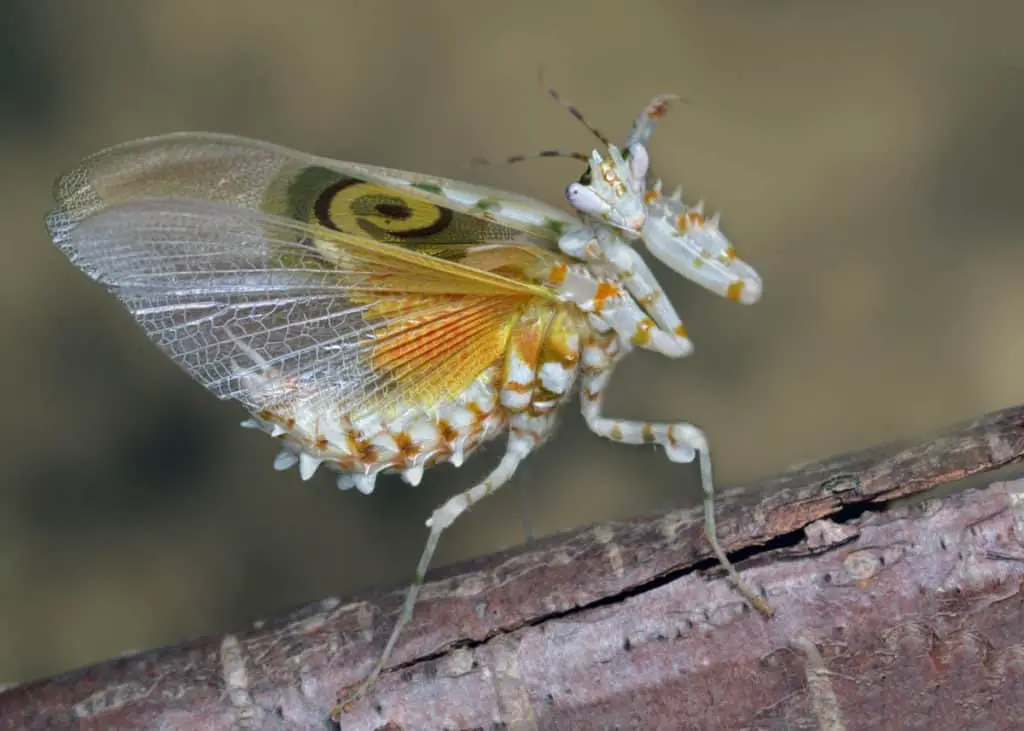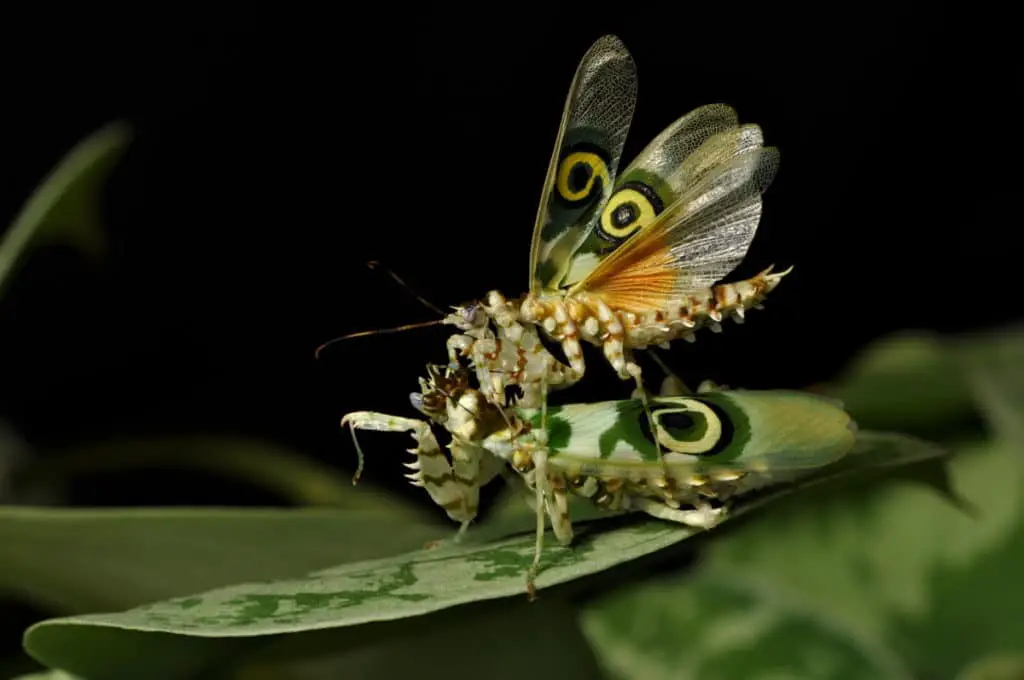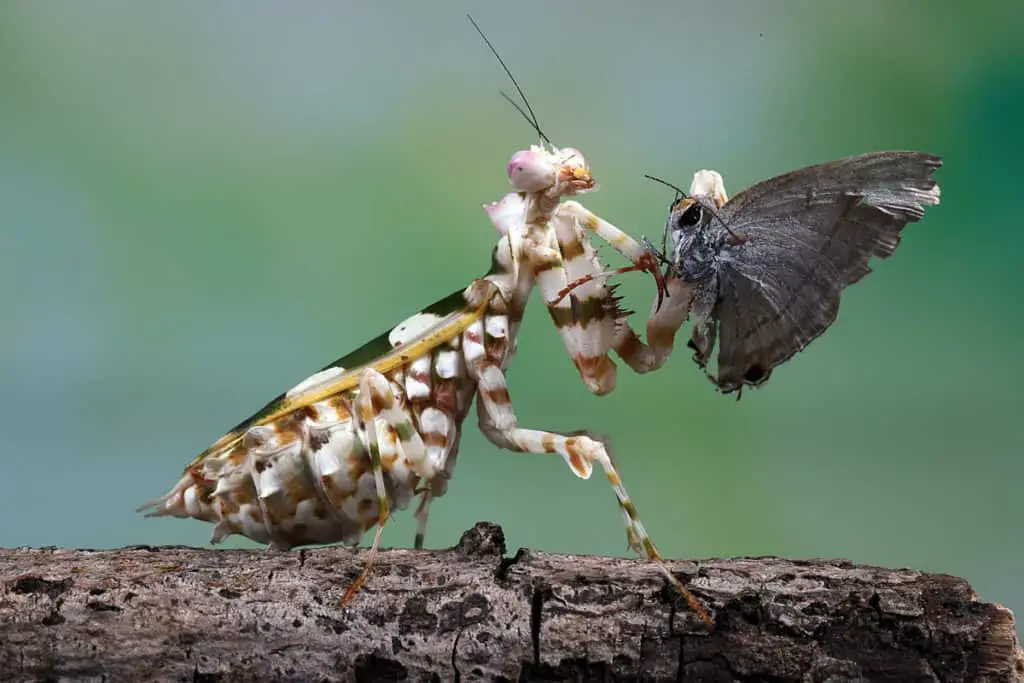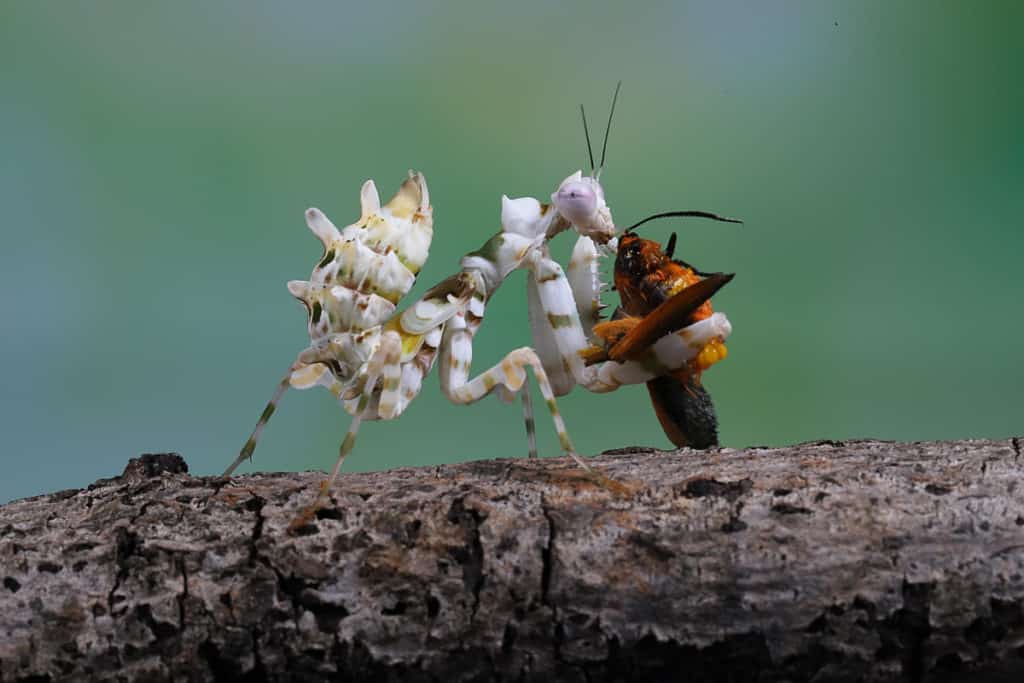The Spiny Flower Mantis is native to sub-Saharan Africa and is also popular as a house pet, they are stunning creatures known for their intricate features and body coloration.
Covered with an elaborate orange spot, purple eyes, and green stripes on their body, an encounter with a spiny flower mantis is sure to leave you in awe.
Read on to find out more about this beautiful species including its habitat, appearance, behavior, life cycle, and feeding habits. This article will also talk about how to keep spiny mantises as pets.
Spiny Flower Mantis: Appearance
Pseudocreobotra Wahlbergii, commonly known as spiny flower mantis got its name due to the spiny structures found on the underside of its abdomen. Native to southern and eastern Africa, the flower mantises measure nearly 1.5 inches in length. Adult males can reach up to 1.5 inches whereas adult females can become 1.75 inches in length.

Most mantises are white and green in color, but some can be tinted yellow, red, or pink depending on the light conditions. The nymphs are black in color until L3 third instar and this makes them look like tiny ants. The little ones have small wings, white spots, and white striped legs. They will change color as they mature, that is, with each subsequent molt.
The large eyespot seen on its forewings is a distinguishing feature of this insect. The eyespot is black in color and is surrounded by white and green colors going in a swirl. Predators, during their encounter with a flower mantis, usually mistake the eyespot to be a giant eye of a larger animal. Therefore, the black eyespot is typically used to scare predators away.
The stripes on their body extend from the head to the back end of the flower mantis. The green and white striped legs of these species also add to their beauty. The forelegs have hooks and barbs typically used to grasp prey and kill it.
Another gorgeous part of this species is its wings. They have two sets of wings, the forewings, and the hindwings. The forewings are stunning to look at as they have a large black eyespot surrounded by yellow and green swirls. The hindwings can be divided into two: the outer hindwings and the inner hindwings. The inner hind wings are orange in color, especially when you go near them. The outer hind wings are transparent with light venation.
Wings are commonly observed to distinguish a female flower mantis from a male flower mantis. This is because the wings of a female are longer than that of a male.
The antennae of these species are a mix of green and cream colors. Males have longer and thicker antennae when compared to females.
Flower mantises also have fleshy lobes on their abdomen. Females have bigger lobes when compared to males.
Spiny Flower Mantis: Sexual Dimorphism
You may already know now that spiny flower mantises exhibit sexual dimorphism, meaning males and females are different in size and appearance.

Here are a few features that will help you distinguish a male flower mantis from a female flower mantis:
- Females have spines towards the base of their wings whereas males do not.
- Males have longer antennae and shorter wings when compared to females.
- Females have bigger fleshy lobes on their abdomen.
- Females molt nearly seven times to reach maturity whereas molt require only six molts.
Spiny Flower Mantis: Defense Mechanism
Spiny flower mantis uses a few strategies to escape from danger. When a flower mantis encounters a predator, it exhibits a startle response where it spreads its forewings so wide to appear large in size. This is called a dramatic display. They also display their eyespots to scare away the predators.
At rest, a flower mantis is well camouflaged as it closely mimics flowers due to its colored body. Their natural camouflage not only helps them hide from predators but also catches prey. Flying insects tend to land on mantises, mistaking them for flowers with nectar. As soon as the insect comes near the mantis, these arthropods will grab the insect and eat it.

Mantises mostly prefer moths and flies. These have a large appetite growing up, so their natural camouflage usually comes in handy to catch flies whenever the mantises are hungry. These can also feed on insects larger than them due to their huge appetite.
Spiny Flower Mantis: Behavior
Spiny flower mantises become active only when their prey is near. They may appear aggressive at times but they are mostly calm and quiet. If threatened, the flower mantis will spread its forewings to appear larger and display its eyespot to scare away the predators.
The baby mantises have a large appetite, so they will try and eat each other until they find real food.
Sexual cannibalism is common among spiny flower mantises. Males are eaten by females after sexual encounters, so the males should be separated right after mating.
Spiny Flower Mantis: Environmental Conditions
Mantises are often kept as pets but some mantises live in the wild. These arthropods that live in the wild are considered endangered. Flower mantises survive in temperatures ranging from 75°F to 85°F.
These insects do not prefer too much humidity as they are prone to fungal infections. Ideally, the humidity should remain at 60%. Proper ventilation is also crucial for the survival of these species.
Spiny Flower Mantis: Life cycle
The lifespan of a spiny flower mantis is 10 to 14 months. And during their lifetime, these arthropods go through three stages: the egg stage, the nymph stage, and the adult stage.
Egg Stage
Mating takes place mostly in the fall season, so the adult female spiny flower mantises lay eggs before winter starts. The mother mantis can lay around 55 eggs at a time. The eggs are kept in an egg case, called an ootheca. After laying eggs, the mother deposits a frosty liquid that hardens over time. Eventually, this will become a hard case that will protect the eggs during the harsh winter.
There are additional spaces for each egg inside the ootheca. And when it is time to hatch, the baby flower mantises crawl through the spaces and come out of the eggs.
Nymph Stage
Nymphs are black in color until the L3 instar stage. Right after coming out of the eggs, the nymphs eat each other up as they have a big appetite. When they finally start their own lives, they will set out to find real food. The nymphs are most vulnerable to predators, so most nymphs don’t make it past this stage.
The food nymphs eat depends on the stage of development. For instance, the L1 through L2 nymphs feed on D. Melanogaster fruit flies while the L3 and L4 nymphs feed on D. Hydei fruit flies.
If you are interested we have a whole article on the diets of nymph praying mantis. The article is called, What Do Baby Praying Mantis Eat?
The Adult Stage
As the baby mantises mature, they start hunting for food and learn to stay away from predators. They become cautious and start using various strategies to defend themselves from their enemies.
The molting process takes about 3 to 4 weeks and the number of molts required to mature is different in females and males. Female mantises require seven molts whereas males molt six times. During molting, they usually hang upside down and wiggle out of the exoskeleton. When these species molt, they become tired and vulnerable to predators. They take a rest on a leaf or a branch and don’t eat much during this time.
Once they reach adulthood, they become stronger and larger. The males will set out in search of females for mating. After mating, most females will eat up the males due to their large appetites. When the females lay eggs, the cycle starts all over again.
To find out more about the diets of adult praying mantis you might be interested in this article we have written, What Do Praying Mantis Eat? (With Video Hunting A Fish)
How To Keep Spiny Flower Mantises As Pets
Spiny flower mantises are often kept as pets as these colorful arthropods are a fun species, a treat to the eyes, and easy to look after. This insect is popular among both beginners and experienced hobbyists.
Here are a few things to keep in mind if you’re planning to keep spiny flower mantises as pets. This detailed guide includes everything you need to know about flower mantises such as their housing, watering, and feeding.
Housing
Like any other insect, spiny flower mantises need their own space. It is best to install a cage for these insects to live in. An ideal living space of flower mantis should contain lots of flowers, twigs, and leaves. Furthermore, there should be adequate space for large-sized nymphs.
Keep the following things in mind while setting up a cage for a flower mantis:
- Fill the cage with twigs, leaves, and a lot of flowers. Mantises prefer silk plants such as orchid flowers or leafy branches.
- The height of the cage should be at least thrice the length of the mantis and the width of the cage should be at least twice the length of the mantis.
- There should be adequate ventilation to control ambient temperature and humidity.
- Install some material on the ceiling of the ceiling so that the mantis can use it to hang upside down during the molting process.
- The ideal temperature inside the cage should be between 75°F to 85°F.
- It is best not to house too many mantises as they may eat each other up due to their large appetite.
- Feed the mantises flying insects like fruits flies, crickets, or houseflies.
Watering
Flower mantises do not demand too much humidity in their space. But make sure to lightly mist the cage once a day so that they can stay hydrated. Keep in mind that they do not like getting sprayed directly, so spray around the insect using distilled water or spring water. Do not use tap water as it can contain chemicals like fluoride and chlorine.
Ideally, the humidity level should remain at 60%; it should not be too high as these species are prone to fungal infections.
Screen or mesh cages are the best options for these species as it is easy to maintain proper humidity in these types of cages.
Feeding
Spiny flower mantises prefer flying insects such as houseflies and crickets. However, the ideal food for these species varies with their developmental stage. If you’re keeping a flower mantis as a pet, follow the care sheet given below to feed the insect with the right food:
L1 through L2 nymphs – D. melanogaster fruit flies.
L3 and L4 nymphs – D. hydei fruit flies.
L5 nymph to adult – House flies or Blue bottle flies. Adults also feed on moths and mealworms.

During the molting process, the mantis will refrain from eating for nearly two days. The molting process usually lasts for 3 to 4 weeks but it depends on the gender of the insects. Females require 7 molts to reach adulthood whereas males molt only 6 times.
Choosing The Gender Of Your Spiny Flower Mantis
As spiny flower mantises exhibit sexual dimorphism, the male and female insects differ in size and appearance. But choosing the gender of the flower mantis to keep as a pet depends on your interest. The maintenance of both genders is nearly the same. The only difference is that the female flower mantises molt 7 times to mature whereas males molt 6 times.
If you’re planning to keep both female and male flower mantises as pets, remember to separate the male after the mating process as these species exhibit sexual cannibalism. The egg sacs should be kept under the same environmental conditions as the mantis. Do not keep the egg sacs in a damp environment as this will lead to the growth of mold on the sacs. Around 30 to 55 baby flower mantises can come out of a single ootheca.
The sex of the insect can be determined by its appearance. The female flower mantises are generally larger, heavier, have bigger lobes on their abdomen, and have spines towards the base of their wings. Males have longer antennae and shorter wings than females.
Summary – Spiny Flower Mantis
| Scientific Name | Pseudocreobotra wahlbergii |
| Common name | Spiny flower mantis |
| Distribution | Sub-Saharan Africa |
| Size | Females can grow up to 1.75 inches in length; males can grow up to 1.5 inches in length |
| Temperature | 75°F to 85°F |
| Humidity | 60% |
| Food | Flying insects, worms |
| Life span | 10 to 14 months |
| Poisonous | No |
| Sexual dimorphism | Yes |
| Sexual cannibalism | Yes |
Frequently Asked Questions About The Spiny Flower Mantis
Are Spiny Flower Mantis Poisonous?
Spiny flower mantises may appear aggressive at times but these tiny arthropods are not poisonous. If threatened, they will spread their forewings and display the eyespot to scare away the predators.
They may produce a chemical to defend themselves but it is not poisonous.
Are Spiny Flower Mantis Good Pets?
Yes, spiny flower mantises make excellent pets for beginner and advanced hobbyists. These insects are fun to watch and easy to look after. All you need to do is set up a cage with the right environmental conditions for the insect and feed them proper food.
The ideal environment for a flower mantis should have 60% humidity and temperature between 75°F to 85°F. Also, mantises as pets should be kept in a cage with lots of twigs, leaves, and flowers.
What Do Spiny Flower Mantis Eat?
Spring flower mantises eat flying insects like crickets and house flies. However, mantises at different developmental stages require different food.
For instance, L1 through L2 nymphs feed on D. melanogaster fruit flies while the L3 and L4 nymphs feed on D. hydei fruit flies. Some mantises also feed on mealworms and wax worms.
How Big Do Spiny Flower Mantis Get?
The average size of a flower mantis is nearly 1.5 inches in length. However, females can go up to 1.75 inches in length.
How Do You Tell Spiny Flower Mantis Males And Females Apart?
As spiny flower mantises exhibit sexual dimorphism, the sex of the mantis can be determined by looking at its features. Female flower mantises are larger and broader than males.
They also have longer wings and spines towards the base of the wings. Furthermore, the fleshy lobes on the abdomen are larger in females. Male flower mantises have longer antennae than females.
The Wrap Up
Spiny flower mantises are stunning creatures commonly kept as pets. Some flower mantises live in the wild but these are considered endangered.
If you’re planning to keep a flower mantis as a pet, make sure you follow the instructions given in this article about the ideal environmental conditions under which a flower mantis can survive.
If you are interested in other species of praying mantis or maybe even keeping a praying mantis as a pet then check out some of these other articles we have written:
Are White Praying Mantises Rare?
The Giant Asian Mantis: Your Complete Guide
The Devil’s Flower Mantis: Your Complete Guide
The Budwing Mantis: Your Complete Guide
The Ghost Mantis: Your Complete Guide
Sources
https://en.wikipedia.org/wiki/Pseudocreobotra_wahlbergi
https://usmantis.com/products/pseudocreobotra-wahlbergii-spiny-flower-mantis
http://creationwiki.org/Spiny_flower_mantis
https://invertepedia.fandom.com/wiki/P._wahlbergii_(Spiny_Flower_Mantis)
https://en.wikipedia.org/wiki/Drosophila_melanogaster
